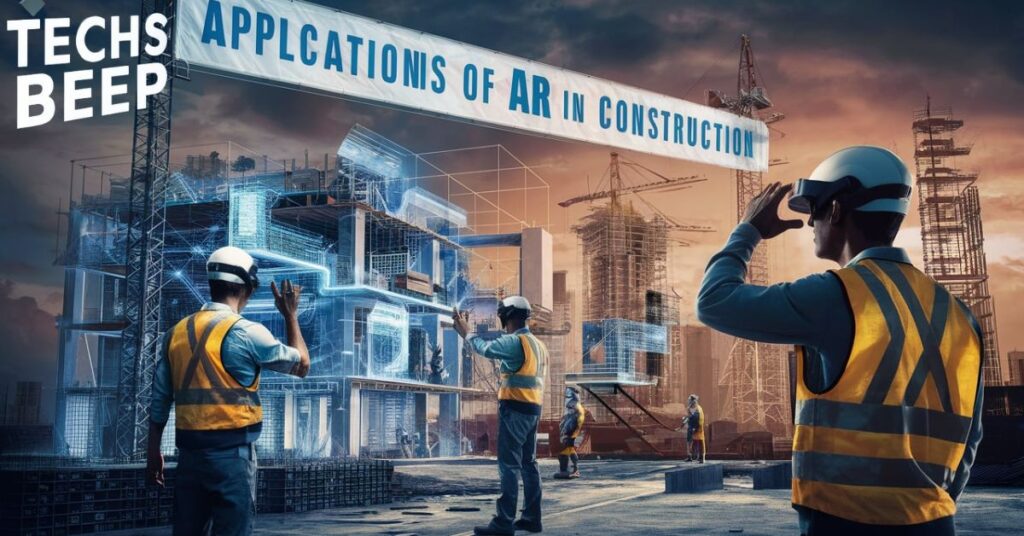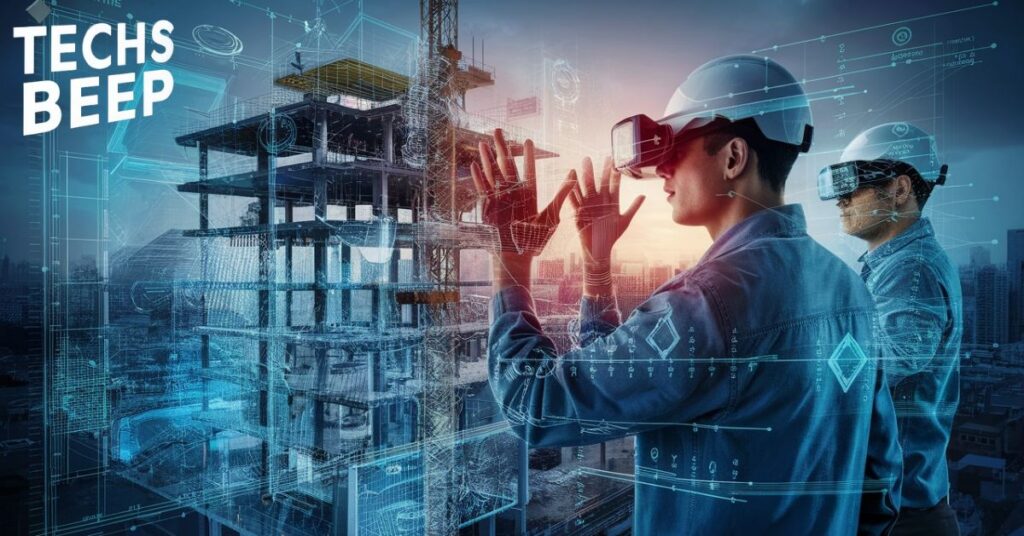Augmented Reality (AR) is transforming the construction industry by overlaying digital information onto the physical world. This blend of virtual and real environments enhances visualization, accuracy, and efficiency in construction projects.
Augmented Reality helps visualize designs on-site, improving decision-making and reducing errors. It also enhances collaboration by allowing stakeholders to interact with the same digital models, minimizing miscommunications.
Augmented Reality streamlines tasks and boosts safety. It provides precise measurements and placements, ensuring perfect fits, and overlays safety information on job sites, preventing accidents. AR promises greater innovation and productivity in construction.
Understanding Augmented Reality in Construction
What is Augmented Reality?
Augmented Reality is a technology that superimposes computer-generated images, information, or data onto a user’s view of the real world.
Unlike Virtual Reality (VR), which creates a completely artificial environment, AR enhances the existing reality by adding digital elements to it.
In the context of construction, Augmented Reality typically involves using mobile devices or specialized headsets to overlay 3D models, measurements, and other relevant information onto the physical construction site or design plans.
The Evolution of AR in Construction
The journey of AR in construction has been one of rapid advancement and growing acceptance. Initially met with skepticism due to high costs and technical limitations, AR has steadily proven its worth in the industry.
Early applications were limited to simple visualization tools, but as the technology matured, it began to offer more sophisticated functionalities.
Today, Augmented Reality is increasingly seen as an indispensable tool in modern construction practices, much like how CAD software revolutionized design processes in previous decades.
Key Components of AR Systems in Construction
Augmented Reality systems in construction typically consist of several key components:
- Hardware: This includes devices like smartphones, tablets, or specialized AR headsets.
- Software: Specialized AR applications designed for construction use.
- Tracking systems: Technologies that allow the AR device to understand its position and orientation in the real world.
- Data sources: 3D models, BIM (Building Information Modeling) data, and other digital information that can be overlaid onto the real world.
Applications of AR in Construction

Design and Planning
In the design and planning phase, Augmented Reality offers unprecedented visualization capabilities. Architects and designers can use Augmented Reality to project 3D models of buildings onto real-world sites.
This allows stakeholders to get a sense of how the finished structure will look and fit into its surroundings. This immersive experience helps in making more informed decisions about design elements, scale, and positioning.
Project Coordination and Collaborationist
Augmented Reality facilitates better collaboration among various stakeholders in a construction project. Team members can use AR to view and interact with the same 3D model simultaneously, regardless of their physical location.
This shared visual reference point helps in resolving conflicts, discussing changes, and ensuring everyone is literally on the same page.
On-Site Construction
On the construction site, Augmented Reality proves invaluable for tasks such as:
- Precise positioning of building elements
- Visualizing hidden infrastructure like plumbing and electrical systems
- Providing step-by-step assembly instructions for complex components
- Measuring distances and dimensions accurately
Safety Training and Hazard Identification
AR can significantly enhance safety in construction by providing immersive training experiences. Workers can practice handling dangerous situations in a safe, virtual environment.
Additionally, AR can be used to highlight potential hazards on-site, overlaying warning signs or safety information onto the worker’s field of view.
Quality Control and Inspection
Augmented Reality tools can assist in quality control processes by overlaying design specifications onto the actual construction.
This allows for easy comparison between the planned and actual results, helping to identify discrepancies quickly.
Inspectors can use AR to access checklists, record findings, and even generate reports in real-time while on-site.
Read this article: An In-Depth Guide About The SWGOH Web Store
Benefits of AR in Construction
Improved Accuracy and Efficiency
By providing precise, real-time information and guidance, AR helps reduce errors and rework. This leads to significant time and cost savings throughout the project lifecycle.
Workers can perform tasks more accurately and efficiently when they have instant access to relevant information in their field of view.
Enhanced Visualization and Communication
Augmented Reality bridges the gap between 2D plans and the 3D reality of construction sites. This improved visualization aids in better understanding of complex designs and helps in communicating ideas more effectively among team members and clients.
The ability to “see” the finished product before it’s built can lead to better decision-making and fewer misunderstandings.
Cost Reduction
While the initial investment in AR technology can be significant, the long-term cost savings are substantial. By reducing errors, minimizing rework, and improving overall efficiency, AR can lead to considerable reductions in project costs.
Additionally, the use of AR for remote collaboration can cut down on travel expenses and time wasted in physical meetings.
Improved Safety
AR contributes to safer construction sites by providing real-time safety information, highlighting potential hazards, and offering immersive safety training.
This proactive approach to safety can lead to fewer accidents and a overall safer work environment.
Streamlined Project Management
Project managers can use AR to get a comprehensive, real-time view of the project status.
By overlaying schedule information, progress reports, and resource allocation data onto the physical site, managers can make more informed decisions and respond quickly to any issues that arise.
Challenges and Limitations

Technology Adoption and Training
One of the primary challenges in implementing Augmented Reality in construction is the need for training and adaptation.
Construction workers and managers need to be trained in using AR devices and software effectively. There can be resistance to change, especially among workers who are accustomed to traditional methods.
Hardware Limitations
Current AR hardware, especially wearable devices, can be bulky and uncomfortable for prolonged use on construction sites.
Battery life, durability in harsh environments, and display quality in bright sunlight are ongoing challenges that manufacturers are working to address.
Data Management and Integration
AR systems rely on accurate, up-to-date data to be effective.
Ensuring that all AR devices on a project are working with the latest information can be challenging, especially on large, complex projects with multiple stakeholders and frequent design changes.
Cost Considerations
While AR can lead to cost savings in the long run, the initial investment in hardware, software, and training can be significant.
Smaller construction firms may find it challenging to justify this upfront cost, despite the potential benefits.
Privacy and Security Concerns
As AR systems collect and process large amounts of data about construction sites and projects, there are concerns about data privacy and security.
Protecting sensitive project information from cyber threats is an ongoing challenge in the implementation of AR technologies.
Future Trends in AR for Construction

Integration with Artificial Intelligence and Machine Learning
The future of AR in construction is likely to see closer integration with AI and machine learning technologies.
This could lead to AR systems that can predict potential issues, suggest optimizations, and even automate certain decision-making processes based on real-time’ data analysis.
Improved Hardware
Advancements in AR hardware are expected to address current limitations.
Future AR devices are likely to be more lightweight, have longer battery life, and offer improved display quality and field of view.
This will make them more practical for everyday use on construction sites.
Expanded Use of Mixed Reality
The line between AR and VR is likely to blur,, with more applications leveraging mixed reality (MR) technologies.
This could allow for even more immersive and interactive experiences in construction planning and execution.
Greater Integration with IoT and BIM
AR is expected to become more tightly integrated with Internet of Things (IoT) sensors and Building Information Modeling (BIM) systems.
This will allow for real-time monitoring of construction progress and immediate visualization of any deviations from the plan.
Standardization and Regulation
As AR becomes more prevalent in construction, we can expect to see the development of industry standards and regulations governing its use.
This will help ensure consistency and reliability across different projects and technologies.
Case Studies

Skanska USA: Improving Efficiency and Safety
Skanska USA, one of the largest construction companies in the United States, has implemented AR technology to improve efficiency and safety on their projects.
By using AR headsets, workers can access building information models on-site, allowing them to visualize complex installations before they begin work.
This has led to a reduction in errors and improved safety by helping workers identify potential hazards before they become issues.
AECOM: Enhancing Client Communication
Global infrastructure firm AECOM has used AR to enhance communication with clients and stakeholders..
By creating AR experiences that allow clients to visualize proposed designs in real-world contexts, AECOM has been able to facilitate better decision-making and client satisfaction.
This approach has been particularly effective in public infrastructure projects, where community engagement is crucial.
Bentley Systems: Streamlining Bridge Inspections
Bentley Systems, a software development company specializing in infrastructure, has developed an AR application for bridge inspections.
The system allows inspectors to access previous inspection data, add new observations, and visualize the internal structure of bridge components while on-site.
This has significantly streamlined the inspection process and improved the accuracy of structural assessments.
Comparison of AR Hardware for Construction
| Feature | Smartphones/Tablets | AR Glasses | AR Helmets |
| Portability | High | Medium | Low |
| Display Quality | Medium | High | High |
| Hands-Free Operation | No | Yes | Yes |
| Battery Life | Medium | Low | Medium |
| Cost | Low | Medium | High |
| Durability | Low | Medium | High |
| Field of View | Limited | Wide | Wide |
| Integration with PPE | Poor | Good | Excellent |
Final Words
In conclusion, augmented reality (AR) is transforming construction by enhancing efficiency and precision. AR allows professionals to visualize designs in real-world settings, reducing errors and streamlining workflows, bridging the gap between digital plans and physical execution.
AR also improves collaboration and communication among construction teams. By providing a shared visual context, AR minimizes misunderstandings and costly rework, while aiding in training and safety by overlaying digital information onto physical environments.
As AR advances, its impact on construction will grow, leading to faster, safer, and higher-quality projects. Embracing AR in construction techniques enhances current capabilities and paves the way for further innovation in the industry.
Frequently Asked Questions
How does AR differ from VR in construction applications?
AR overlays digital information on the real world, while VR creates a fully immersive digital environment.
Can AR technology work offline on construction sites?
Some AR applications can work offline, but many require internet connectivity for real-time data updates.
Is AR technology suitable for all types of construction projects?
While beneficial for most projects, AR is particularly valuable for complex, large-scale constructions.
How does AR improve safety on construction sites?
AR can highlight hazards, provide safety information, and offer immersive training experiences.
What is the typical return on investment for implementing AR in construction?
ROI varies, but many companies report significant savings in time, reduced errors, and improved efficiency.








